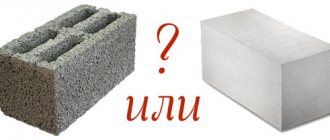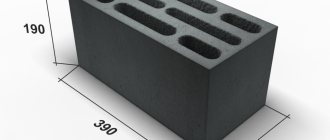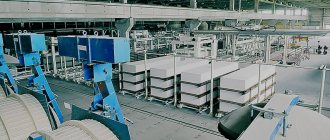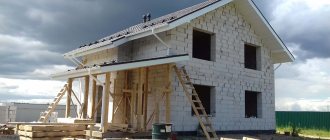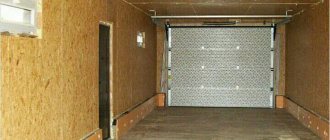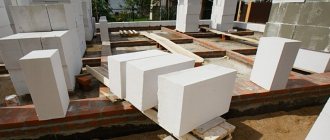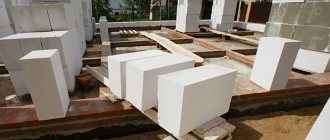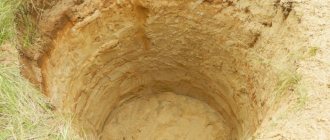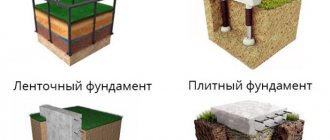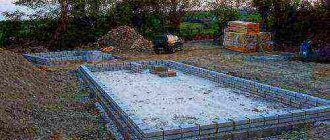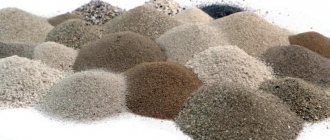Increasingly, individual developers are choosing timber or foam blocks when constructing country or residential buildings, due to the excellent characteristics of the materials. Thanks to the above-mentioned products made of wood and cellular concrete, it is possible to build cost-effective houses, and in both cases the work is carried out quite quickly. In addition, their construction, if necessary, can be done by hand.
Foundation option for structures made of these materials.
Comparison of the characteristics of wood beams and foam concrete blocks
- The environmental friendliness of materials in our time of megacities and developed industry is very valuable. And in this case, we will undoubtedly give priority to natural wood, because it has the ability to “breathe”, that is, to allow air to pass through.
- The sound and heat insulation qualities of timber and foam concrete are approximately the same. Both materials have good sound insulation. But the ability of timber to retain heat directly depends on its thickness; a house with thin walls requires additional thermal insulation.
- The degree of moisture resistance and ability to withstand environmental influences is much higher for foam blocks, but this characteristic can only be attributed to solid blocks that have not expired. Over time, foam concrete material undergoes cracking and crumbling, so its ability to retain moisture decreases.
- There is no doubt that the fire resistance of foam blocks is clearly superior to that of wooden beams. In this sense, foam concrete is completely safe, since it is not a flammable material, which cannot be said about flammable wood.
However, not every house made of wooden beams can be left without finishing (except for expensive laminated veneer lumber). After covering a wooden house with plasterboard, water- and windproof films, its ability to pass air drops sharply. And without finishing, the service life of a wooden house is reduced.
Foam blocks are made from lightweight foam concrete with a cellular structure, which creates relative air permeability. But, at the same time, it cannot be called natural and environmentally friendly. This is its minus.
The thermal insulation qualities of foam concrete are directly proportional to the operating conditions; the high hygroscopicity of the material reduces its thermal insulation characteristics. In this case, it is difficult to give preference to any one of these materials, because both timber and foam concrete have their pros and cons.
Wooden beams also do not compare favorably in this sense, since the porous structure of wood causes greater moisture absorption. Moreover, from frequent exposure to precipitation, wood can rot and develop fungus, and without additional impregnation with special means, the wood quickly fails. Therefore, we will still leave priority in moisture resistance to foam blocks.
Do-it-yourself foam block partition.
You will read about this in our next article. And this article talks about glue for foam blocks.
Log houses
Dwellings have been built with logs since ancient times; they also remain a popular material now. Log houses have good heat resistance in winter and coolness in hot weather, environmental friendliness, and sound insulation.
Disadvantages: flammability, shrinkage, various types of destruction by external environmental factors, for this it needs to be treated every year from rotting and various kinds of rodents. The cost of log house housing will be 18,000 - 80,000 per m^2, depending on the type of wood.
A house made of timber or foam blocks: which is easier and faster to build?
Modern construction techniques make it possible to build wooden houses quite quickly in just a few months. Especially if you plan to build from glued or dried profiled timber on a turnkey basis. There are ready-to-assemble houses made of timber with fitted tongues and grooves. Such a house can be assembled easily, like a construction kit, in just a couple of weeks, because each beam is laid precisely according to the prepared pattern.
It’s another matter if the house is built from less expensive timber with normal humidity. Then the construction of the house may take more than a year, because you will have to wait until the constructed “box” shrinks.
As for finishing a wooden house , it is not needed only in buildings made of high-quality laminated veneer lumber. Ordinary wood after shrinkage does not look very attractive and requires additional finishing. In addition, a house with good thermal insulation will definitely lose outwardly.
Building a house from foam blocks compares favorably with building wooden houses, because you don’t have to wait for the structure to shrink. From light-weight and impressive-sized “bricks”, the walls and partitions of the house are put together quickly and without any problems. This material is very malleable in processing and can be easily sawed with a regular hacksaw.
But there is a “underwater pebble” here too. Not all manufacturers of foam concrete blocks carefully monitor their compliance with the exact dimensions. Small businesses often sell blocks that are not quite geometrically straight. Their adjustment and alignment may take some time and delay the construction of the house. Therefore, we advise you to purchase foam blocks from large manufacturers with proven quality of building materials.
Speaking about home design, one cannot fail to mention that foam blocks make it possible to bring the most daring ideas to life, thanks to their flexibility in processing. Wood is a less advantageous material in this regard, as it tends to deform under different weather conditions.
And the finishing of walls made of foam concrete can be very diverse: plastering, tiling, wall panels, artificial or natural stone.
Pros and cons of building a timber bathhouse
The advantages of constructing a timber bathhouse have long been well known. They are the main reason for this construction option and are as follows:
- Creating a favorable microclimate inside the building, which is ensured by the vapor permeability of the material;
- Environmental friendliness. In this parameter, only a log bathhouse competes with a timber bathhouse;
- Light weight, allowing the construction of the simplest type of foundation;
- Durability and strength of the building, which are complemented by the simplicity of construction technology;
- Availability of the material, since services for the manufacture and installation of log houses are offered by a large number of manufacturing enterprises;
The main disadvantage of a timber bathhouse is the need for a break in construction, which is required for the shrinkage of the log house. Depending on the quality of the source material, its duration ranges from six months to one and a half years.
Which is cheaper?
What is cheaper: foam block or timber? The answer to this question is not as simple as it seems at first glance. On the one hand, a cubic meter of foam concrete blocks costs half as much as the same volume of profiled timber made from wood with natural moisture, not to mention expensive dried laminated veneer lumber.
But if we take into account what the total cost of building a house from these materials will cost, then in this case the advantage will still be on the side of laminated timber. After all, this wonderful material does not require finishing and is built on a simple, inexpensive foundation.
Therefore, when building a house from foam concrete blocks, while saving on the cost of the base material, you can lose on the costs of laying the foundation and finishing the walls .
Garage made of foam blocks. Photos and article about it here. And here the pros and cons of foam blocks are discussed in more detail.
This section of our website contains all the most important and necessary information about the roof of a house.
An original solution to difficult problems
If you can’t make a decision, then there is one way out - building a combined house. Yes, there are few such houses, but they are appearing more and more often. During construction, timber is combined with foam blocks. It all depends on the architecture of the future building. To build a classic two-story house, a division by floor is used. The first one is made from timber, and the second one is made from foam block. The foam block will allow you to create interesting solutions for roofs, balconies, attics, and a durable wooden floor will become an excellent foundation for the structure. This combination of materials looks modern and stylish. The duet can be diluted with large floor-to-ceiling windows or glass balconies, which will make the building more futuristic.
Conclusion
Exclusive wooden house project
In general, building a house made of wood will cost more than building it from foam concrete blocks. And depending on the region, the difference can reach significant amounts. The fact is that the production of foam concrete can be established almost anywhere, but wooden building materials have to be imported.
But on the other hand, people began to pay more attention to the environmental components of their lives, so it’s up to you to decide. The video in this article will tell your point of view on this matter - watch it!
Nuances associated with foam blocks:
- Environmental cleanliness is questionable. This applies to cellular options made in an artisanal way - cinder blocks. But factory elements also cannot provide a complete guarantee of crystal raw materials.
- It is not possible, unlike timber, to build multi-storey buildings - the foam block can withstand certain loads and does not have the elasticity of wood. In addition, freezing and interaction with precipitation contribute to its destruction.
- Requires mandatory lining. Firstly, it is not presentable, and secondly, moisture from the outside will destroy it over time.
- It is cheap, unlike wood. But the savings are mythical if the material was purchased not from a recommended manufacturer, but in a garage.
- Foam block requires reinforcement when it comes to load-bearing walls. This, in turn, will affect the cost of the rod and a special machine for gating - cutting out grooves for the inlays.
The main advantage of the described raw materials is the speed of construction, due to the size and lightness of the elements. And if we talk about a quick housewarming, then the question is better to build a house from timber or foam blocks, the answer suggests itself.
What kind of wood to build a bathhouse from?
If a log is sawed or trimmed on two or four sides, the result is a beam, the thickness of which, as a rule, starts from 100 mm. The section of the beam is a rectangle or square with an aspect ratio not exceeding 1:2.
A log, also called a round log, is obtained by cleaning cut trees from knots, bark and branches, sawing it to the required length across the trunk.
The comparison of these two materials below will help you decide on what is better to build a bathhouse from: timber or logs:
- The core of solid logs is protected from weather conditions by the skin of the wooden trunk, but timber does not have such protection.
- Possible annual shrinkage for a log house is 10-12 cm, and for a log house - 6-10 cm.
- According to the manufacturing technology, a log house made of timber is much simpler than a log house made of logs.
- It is better not to order a finished log house, since some of the log beams may “sink” when dried, i.e. they will serve as a “propeller”, making the assembly of such a log house impossible without replacing unsuitable beams. Logs are less susceptible to hygroscopicity, therefore, a ready-made log house can be purchased without any fear. Just when purchasing, be sure to pay attention to the presence of numbering on all crowns, otherwise when dismantling and transporting the log house, the work on its construction will be seriously complicated.
- The drying process causes cracking of logs, mainly vertically, although cracks on them can also appear on the sides, but in small quantities. In timber, the direction of cracks is chaotic and unpredictable.
But, nevertheless, it is timber, according to numerous reviews from happy owners of bathhouses, that is the ideal material for the construction of this structure (see Building a bathhouse from timber with your own hands). It is technologically advanced, easily covered with clapboard (along the joists) from the steam room side, and it is easy to attach external insulation elements, such as a ventilation façade, to it. But, probably, the most important thing is that today the market offers already dried timber, therefore, finishing the log house of such a bathhouse can begin immediately.
Judging by the reviews, in the construction of baths, pine timber is often used, trimmed on the inside with boards or lining made of spruce or hardwood, with a mandatory air gap between the walls and the finishing to ensure ventilation.
In general, wood from a variety of wood species can be used in the construction of a bathhouse. For example, oak logs are perfect for foundation pillars, floor joists, and the lower crown of a bathhouse frame. And for the third and fourth crowns, larch or pine will be good. The upper crowns, as well as the internal lining of the walls and ceiling of the bathhouse, are best made from linden or spruce.
Basic recommendations
Those who have a summer cottage very often think about the need to build a small house. So that it is cozy and comfortable. But before starting construction work, we need to come to a solution to very important issues. The first and mandatory choice will be the choice of material for construction. In this case, foam block or timber. At the same time, it is necessary to ensure that the construction itself is fast and cheap.
Article on the topic: How to attach timber racks to a frame house
To build a country house, you need to purchase only the highest quality materials. Experts recommend choosing foam blocks that have the correct geometric shapes. And they are made of high quality concrete. And if you stop at choosing a budget option for developments, you may end up with protracted, lengthy and annoying work.
For this reason, there is no need to spend money on irregularly shaped foam blocks or lumber that still retains its natural moisture content. But from numerous reviews it can be understood that when constructing a building from concrete foam blocks, you can save a lot of your time. This makes it possible to understand that when working with such material, special-purpose lifting equipment will not be required, and there will be no need to wait for a long time for the building to shrink.
To fully analyze the question of what would make a better house, timber (lumber) or foam block (cellular concrete), you need to make a calculation comparing environmental friendliness and functionality. Any modern manufacturer prefers concrete blocks because they are both cheaper and absolutely not harmful to human health. The non-flammable material is 100% resistant to rotting. But no one can argue with the fact that wood was and still is the most environmentally friendly material. And moreover, it has a unique ability to regulate the level of humidity in the air. And for this reason, it requires additional treatment, which is carried out using antiseptic and other substances designed to protect the wood from cracks, insects and fungus.
A house made of foam concrete does not require mandatory external finishing and insulation of walls and roof. But without such additional finishing work, the building will look like a gray and dull structure, and in winter the built house will be very cold inside. And if during the construction of wooden houses material from high-quality and expensive timber (for example, glued) is used, the building does not require excessive cladding of the facade.
Therefore, a house in the construction of which high-quality timber materials are used will require a lot of additional and serious investments of money. This is about building a house for permanent residence. And if we talk about a summer house, then for the construction of such a house it is recommended to use a more affordable material with a natural level of humidity. A budget option for permanent residence is to build a house from concrete foam blocks.
Article on the topic: How to build a utility block from timber
Thermal, sound and moisture insulation
The first characteristic determines the thickness of the wall or the need to install insulation. It should be noted here that timber processing involves longitudinal cutting of the densest tree rings from the trunk. This reduces the thermal insulation properties of the material relative to solid logs. You can avoid the formation of frost on the surface of the walls and in the corners of the house, and also get rid of the penetration of cold:
- if the width of the beam is taken in accordance with thermal calculations;
- if we ensure maximum compliance with the assembly technology, which provides for the absence of through gaps between the rims.
You will have to take care of additional insulation of the building frame if, for one reason or another, the lumber turns out to be thinner than the design parameters. The insulator is installed both outside and inside the house. In the first case, wall cladding will also be required.
With identical requirements for thermal insulation of walls, its thickness from a foam block may be slightly less than from timber. The low thermal conductivity of cellular concrete is ensured by the porous structure of the material, which retains air bubbles that perform the function of thermal protection.
As for the sound insulation of timber, it is difficult to find any cons here. Unless the walls have large cracks, holes or are thin. If the thickness is sufficient, the noise waves will be extinguished before they pass through the load-bearing fence of the house. Foam block is also a wonderful sound insulator, and double stone masonry will help increase its protective function.
Without treatment with special impregnating and coloring compounds, the timber uncontrollably absorbs and releases moisture. On a small scale, this can be seen in the wooden entrance door swelling in wet weather. Everyone in their life has ever encountered a similar phenomenon, so they can imagine what will happen if not the door leaf, but the timber within the entire house increases in volume. From this it should be concluded that it will not be possible to do without protective moisture-resistant treatment.
The porous structure of the foam block not only offers advantages in the form of good thermal insulation and lightening of load-bearing walls, but is also, at the same time, a significant disadvantage of the material. The presence of small cells in the stone ensures its hygroscopicity. And this, under certain operating conditions and with direct exposure to precipitation, means rapid wetting of the walls. A wet foam block loses its thermal insulation qualities, so the outer side of the walls requires mandatory protection from moisture.
Analyzing the above comparisons in terms of heat, sound and moisture protection, we can say that both the timber and the foam block are almost identical.
Comparing building materials
It’s logical to start with a brief description of the materials:
- foam blocks. They are made of cellular concrete, have a porous structure, due to which they have good thermal insulation characteristics, give slight shrinkage, do not burn, but absorb moisture, so frost resistance directly depends on the quality of the finish. Because the technology for producing foam concrete blocks is relatively simple; the market offers not only products from leading enterprises, but also homemade building materials of dubious quality;
- timber It is made of wood, so it is flammable. There are solid, profiled and glued materials. Its cost and characteristics are largely determined by the moisture content of the timber. It is produced in different sizes: the greater the width and thickness, the more expensive it is, and accordingly, how much timber in a cube depends on the geometric dimensions of the building material
House made of timber or foam block?
As a rule, if the construction of a house for permanent residence is being considered, then it is better to give preference to material made of cellular concrete. Even despite the demanding construction of an expensive foundation, foam concrete houses are more consistent with modern concepts of comfortable housing. At the same time, prices for houses made of timber are often higher, which is due to the high cost of high-quality lumber. The most affordable of them are suitable, perhaps, for the construction of a country house.
What is cheaper - timber or foam block?
Even if we compare solid timber with natural humidity (the cheapest) with foam blocks, its cost per cube will be at least 2 times higher. The price for dry timber is even higher, but you can keep silent about glued timber. But we must not forget that the cost of a cube is far from the cost of the whole house!
It turns out that a high-quality house made of timber requires serious investments, especially when it comes to construction for permanent residence. Another thing is the dacha. To build a country house, you can use material with natural humidity that is quite affordable. A budget option for permanent residence is a construction made of foam blocks.
Article on the topic: How to install a polycarbonate greenhouse on timber
Environmental friendliness
Wood attracts with its natural texture, incredible attractiveness and aesthetics, and the ability to create comfort and coziness inside the house. Solid timber is 100% environmentally friendly, unless, of course, the timber was harvested in “polluted” areas. The situation is a little worse with laminated lumber, since synthetic adhesives are used in its production.
The technology for the production of cellular concrete provides for the presence of foaming agents in the mixture, which can be based on both organic and synthetic components. Therefore, it is wrong to say that foam block is environmentally friendly, especially if its cost is low. Recently, manufacturers have been trying to introduce protein foaming agents into solutions, taking advantage of technological innovations and abandoning inexpensive synthetics, which undoubtedly increases the environmental friendliness of artificial stone.
Both materials are breathable, and therefore create an optimal microclimate in the interior, which has a beneficial effect on the health of people living in the house.
In the matter of environmental safety, the palm should still be given to timber. But if the question depends only on this parameter, then a high-quality foam block from a trusted manufacturer can be a good alternative to laminated wood. In addition, we must not forget that any timber at the processing stage and during operation requires impregnation with fire retardants and antiseptics, which can negatively affect the environmental friendliness of a wooden house. Of course, it all depends on the compounds used.
Article on the topic: Do you need interior decoration of a house made of profiled timber?

